-- From Islamabad to Skardu and Khaplu
Approach the Kashmir dispute
- The map presents the GPS tracklog, in blue, of the current trip from Islamabad to
Khaplu via Skardu and the tracklog, in red, of the trip in May from Jammu
to Leh via Kargil. The colour of the tracklog does not make sense. Thus the
effects of the partition of the Indies appear clearly for the historical area
of Jammu & Kashmir which extended from the valleys of Gilgit and Hunza to
Ladakh. The old caravan roads crossed by the valleys of Indus River, Jhelum
River and Shyok River. The cease-fire Line of UN holds place of international
border. The border between Muzaffarabad and Srinagar is closed. The geographical unit is natural.
- The settlement of Ladakh is of Tibetan yellow race of Buddhist religion and
of Indo-European race, Dardes, of Islamic religion. The valley of Kashmir is
primarily made up of Dardes Moslem with a strong community Hindu. The
settlement of Baltistan is composed of Baltis Shiites. Azad Jammu & Kashmir,
area of Muzaffarabad, are populated with Dardes Sunnites. The political unit
remains to become about it.
- The unit of the area was fictitiously maintained by British Raj. The current
situation is the resultant of the choice of the Hindu maharaja of Jammu &
Kashmir and the UN decision, Line off Control. Independence and partition
reflect in obviousness the problem existing ethnico-religious since the
collapse of the Mughal Empire devoting the incompletion of the expansion of
Islam and the revival of Hinduism.
- The economic development of the two areas, Pakistan and India, does not
reach the same level. Srinagar is a modern city in full industrial and tourist
rise. Ladakh profits from the repercussions of the Indian military presence.
On the other hand Baltistan, Skardu, remain by traditional tourism existing
well before the partition, expeditions towards the great summits and trekking
in the valleys. At that moment I did not visit Azad Jammu & Kashmir,
restricted area. The standard of life of the two areas is much contrasted.
- India is a country of religious tolerance where the three great ancestral
religions and Islam (12% of the population) cohabit. In the Land of Pure, Pakistan,
the interethnic clashes are
not rare. The official language, the Urdu, is spoken per less than 10% of the
population. Islam is the religion of more than 96% of the population. The
religious opposition between orthodox and moderate takes an increasingly
strong acuity.
The respective animosity of the two people makes problematic, in the short
time, a political solution of the conflict of Kashmir.
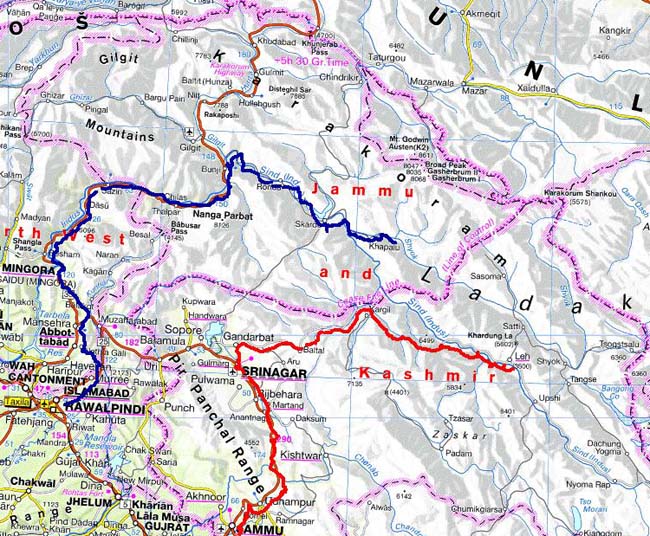
The road tracklog
from Islamabad to Skardu & Khaplu
from 09/06 to 17/06/2007
The morning of the departure northwards, 09/06, and after the last preparations, I have a last meeting with the German-French man arrived yesterday by motor bike from the north areas of Pakistan. I was in company of Etienne arrived himself also yesterday by 2cv. Information collected was invaluable to avoid some pitfalls, for example, not to take the road from Chitral to Dir under work for the construction of a tunnel. I left Islamabad after having filled the tank with diesel around 10:30. In this Saturday the traffic was very heavy on the road to Murree where I arrived about 12:00. I stopped at the following village to lunch of a ragout of sheep and chapatis. I thought of finding a bivouac in Nathiagali. Alas the village is built along the road without carpark for my truck. At approximately 10 kilometres from Abbottabad a vast platform along a torrent was occupied by a Large Wheel and various games. I decided to install the bivouac there, the place is called Harnou. On my arrival there was nobody. Gradually the motorists stopped there and the Large Wheel was started. At the night fallen the visitors left, I were only. The night was pleasant, without noise and muezzin.
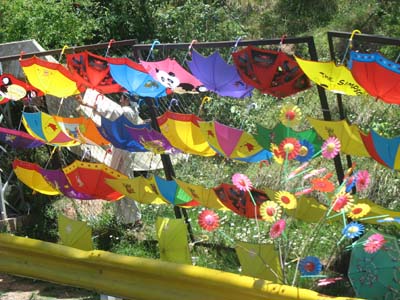
Umbrellas
en route
the 09/06/2007
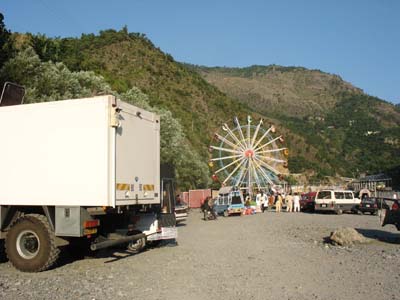
Campsite
Harnou
the 09/06/2007
I left the Great Wheel around 09:00 to join the KKH in Abbottbad, large city with very populous suburbs. The landscapes became interesting after Batgram. The road curves between medium mountains cultivated in terrace overhanging deep canyons. It descends a valley whose torrent flows into the Indus River which is crossed by the Chinese bridge in Thakot. The police control after the bridge consisted in filling oneself a register without getting out of the truck. I arrived in Besham about 17:30 where I met at the entry a camp-site-driver seen in Tourist campsite in Islamabad. The cybercafé was not open. I establish my bivouac in Besham Midway Hotel where I dined.
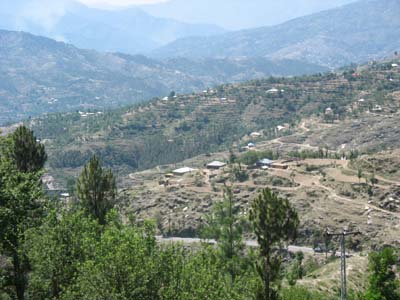
Landscape
en route
the 10/06/2007
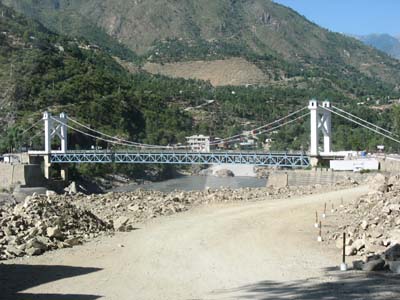
Indus river bridge
Thakot
the 10/06/2007
The 11/06 I had decided to go up to Chilas. After Besham the road curves in the mountains in dramatic landscapes. However the carriageway surface was much degraded. I reached Dasu about midday. The parking in mountain being very difficult, I found a site in the shade against the rock face for the lunch pause. After Barseen the road on left bank of Indus River is of good quality. I arrived in Chilas before 17:00 to establish the bivouac at the Chilas Inn. The manager required 600 KPR for the night. After negotiation the price was 200 KPR. I met a French couple there I had made knowledge in Tourist campsite in Islamabad. During the diner at the restaurant of the hotel we exchanged information for the continuation of the trip.
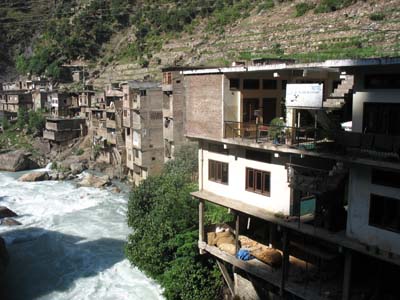
Dasu
11/06/2007
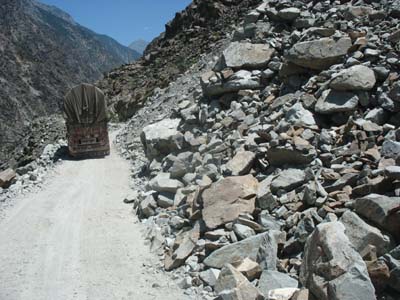
Landslide
en route
11/06/2007
The 12/06 I left my friends around 08:00 after ultimate exchanges of information. They
turned over to Islamabad to take their Indian visas then to move towards
Ladakh. I arrived around 11:00 in Jaglot where I took a brunch wishing to
reach Skardu before the night. I crossed the Gilgit River Bridge at 11:30. A
control of police is located other side; there as previously I registered
myself on the register. The road to Skardu skirts the Indus River with
tumultuous floods during 170 Kilometres. It is built at mountainside in deep
canyons and sometimes cut arches in the rock leaving a height of hardly 4
meters. Moreover it is with single lane requiring an extreme attention at the
time of the crossing of cars and especially trucks. I should reverse rather
delicate. The surface of the roadway is very variable from correct to very disintegrate.
The valley is so narrow that sometimes the GPS lost the satellite signal; thus
the trace on the map has discontinuities. I entered Skardu about 17:30 and I
installed my bivouac at the PTDC K2 Motel around 18:00. After negotiation the
manager granted the free carpark if I had diner at the restaurant.
The two pictures show the junction of Indus River and Gilgit River at the
crossing of three mountainous massifs, the Himalayas, Karakoram and Hindukush.
Indus stumbles over Hindukush consequently its stream moves towards the south.
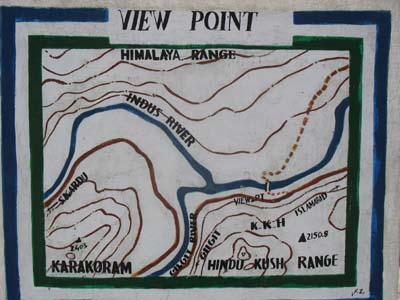
View point
en route on the KKH
12/06/2007
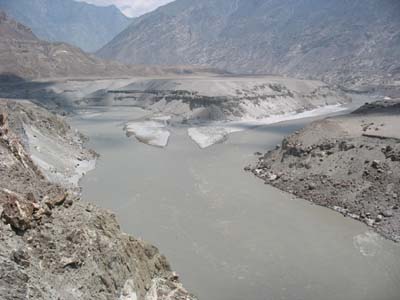
Confluence of Indus and Gilgit
en route on the KKH
12/06/2007
From the 13 to 15 June included I bivouacked at the PTDC K2 Motel in spite of an environment not very exciting. I visited the town of Skardu. It is located in a broad valley of the Indus River strewn with sand banks which the wind in the evening raises in swirls of dust. Snuggled at the foot of Karpochu it is built along the bazaar where shops of clothing, car accessories, articles of trekking and travel agencies mix. Indeed Skardu is the starting base of climbs and treks to the great summits in Pakistan, K2, Broad Peak, and Hidden Peak for the most 8000 meters high. I had rest in the garden of K2 Motel by finalizing the road plan until the 13/07 date of my return to Islamabad to take the Indian visa and to await the new passport expected the following week.
The 16/06 I decided to visit the Khaplu city to a hundred kilometres from Skardu. The
weather was gloomy. The road is beautiful along the Indus River then the Shyok
River. I entered the city with my truck and I had many difficulties by
extracting it with the benevolent assistance from the police. At the
return on the main road, I parked it at the junction of the two roads. Then on
foot I went to visit the Palace of Khaplu. Halfway I was takken by jeep of
the army and at the return by a local van; it is the kindness of Pakistanis. The
palace in ruin is under rehabilitation by Aga Khan Trust and the Government of
Norway.
Impossibility of finding a bivouac and being degraded weather, I went again to
Skardu to bivouac close to the PTDC Sadpara Motel overhanging the Satpara
Lake. I spent Sunday 17/06 there.
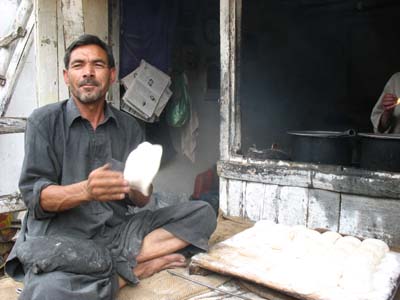
the baker
Khaplu
16/06/2007
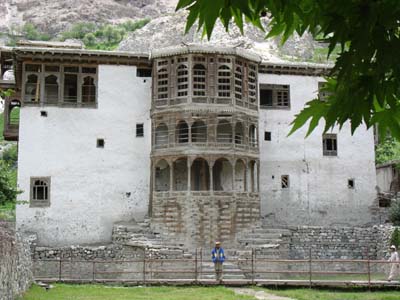
The Palace
Khaplu
16/06/2007
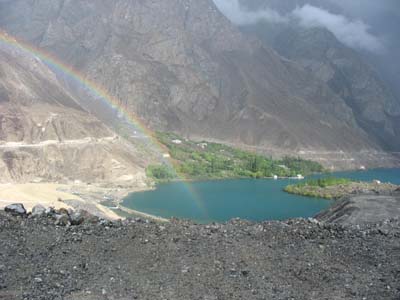
Satpara Lake
Skardu
16/06/2007